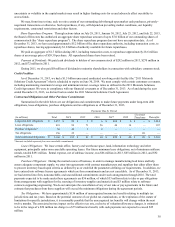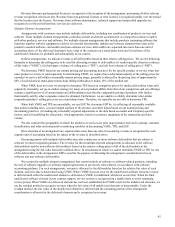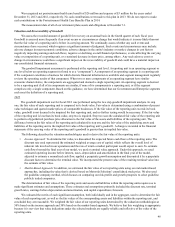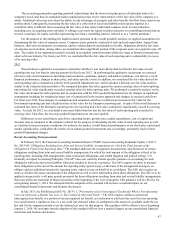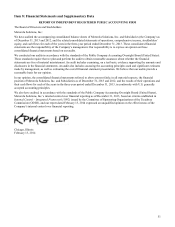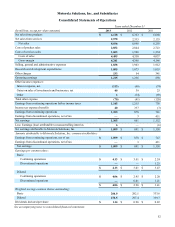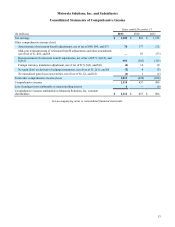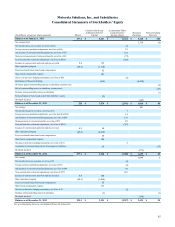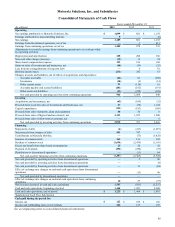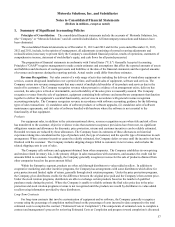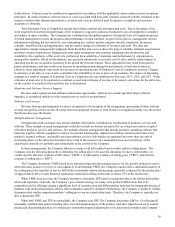Motorola 2013 Annual Report Download - page 50
Download and view the complete annual report
Please find page 50 of the 2013 Motorola annual report below. You can navigate through the pages in the report by either clicking on the pages listed below, or by using the keyword search tool below to find specific information within the annual report.48
In January 2014, the FASB issued ASU No. 2014-05, “Service Concession Arrangements.” The ASU clarifies that an
operating entity should not account for a services concession arrangement with a public-sector grantor as a lease if: (i) the
grantor controls or has the ability to modify or approve the services the operating entity must provide, to whom it must provide
them, and at what price and (ii) the grantor controls any residual interest in the infrastructure at the end of the arrangement. In
addition, the infrastructure used in a service concession arrangement would not be recognized as property, plant and equipment
of the operating entity. The ASU is to be applied on a modified retrospective basis to service concession arrangements
outstanding upon adoption and will be effective for us beginning January 1, 2015. We are currently assessing the impact of this
standard on our consolidated financial statements and footnote disclosures.
Forward-Looking Statements
Except for historical matters, the matters discussed in this Form 10-K are forward-looking statements that involve risks
and uncertainties. Forward-looking statements include, but are not limited to, statements under the following headings:
(1) “Business,” about: (a) industry growth and demand, including opportunities resulting from such growth, (b) customer
spending, (c) the impact of each segment's strategy, (d) the impact from the loss of key customers, (e) competitive position,
(f) increased competition, (g) the impact of regulatory matters, (h) the impact from the allocation and regulation of spectrum,
(i) the availability of materials and components, energy supplies and labor, (j) the seasonality of the business, (k) the firmness
of each segment's backlog, (l) the competitiveness of the patent portfolio, and (m) the impact of research and development;
(2) “Properties,” about the consequences of a disruption in manufacturing; (3) “Legal Proceedings,” about the ultimate
disposition of pending legal matters and timing; (4) “Management's Discussion and Analysis,” about: (a) market growth/
contraction, demand, spending and resulting opportunities, (b) the increase in public safety LTE revenues in 2015, (c) the
decline in iDEN, (d) the return of capital to shareholders through dividends and/or repurchasing shares, (e) the success of our
business strategy and portfolio, (f) future payments, charges, use of accruals and expected cost-saving and profitability benefits
associated with our reorganization of business programs and employee separation costs, (g) our ability and cost to repatriate
funds, (h) the impact of the timing and level of sales and the geographic location of such sales, (i) the impact of maintaining
inventory, (j) future cash contributions to pension plans or retiree health benefit plans, (k) the liquidity of our investments,
(l) our ability and cost to access the capital markets, (m) our ability to borrow and the amount available under our credit
facilities, (n) our ability to retire outstanding debt, (o) our ability and cost to obtain performance related bonds, (p) adequacy of
resources to fund expected working capital and capital expenditure measurements, (q) expected payments pursuant to
commitments under long-term agreements, (r) the ability to meet minimum purchase obligations, (s) our ability to sell accounts
receivable and the terms and amounts of such sales, (t) the outcome and effect of ongoing and future legal proceedings, (u) the
impact of recent accounting pronouncements on our financial statements, (v) the impact of the loss of key customers, and
(w) the expected effective tax rate and deductibility of certain items; and (5) “Quantitative and Qualitative Disclosures about
Market Risk,” about: (a) the impact of foreign currency exchange risks, (b) future hedging activity and expectations of the
Company, and (c) the ability of counterparties to financial instruments to perform their obligations.
Some of the risk factors that affect the Company’s business and financial results are discussed in “Item 1A: Risk
Factors.” We wish to caution the reader that the risk factors discussed in “Item 1A: Risk Factors,” and those described
elsewhere in this report or in our other Securities and Exchange Commission filings, could cause our actual results to differ
materially from those stated in the forward-looking statements.
Item 7A. Quantitative and Qualitative Disclosures About Market Risk
Interest Rate Risk
As of December 31, 2013, we have $2.5 billion of long-term debt, including the current portion of long-term debt, which
is primarily priced at long-term, fixed interest rates. Of this total long-term debt amount, a $36 million Euro-denominated
variable interest loan has a hedge that changes the interest rate characteristics from variable to fixed-rate. A hypothetical
unfavorable movement of 10% in the interest rates would have an immaterial impact on the hedge’s fair value.
Foreign Currency Risk
We use financial instruments to reduce our overall exposure to the effects of currency fluctuations on cash flows. Our
policy prohibits speculation in financial instruments for profit on exchange rate price fluctuations, trading in currencies for
which there are no underlying exposures, or entering into transactions for any currency to intentionally increase the underlying
exposure. Instruments that are designated as part of a hedging relationship must be effective at reducing the risk associated with
the exposure being hedged and are designated as part of a hedging relationship at the inception of the contract. Accordingly,
changes in the market values of hedge instruments must be highly correlated with changes in market values of the underlying
hedged items both at the inception of the hedge and over the life of the hedge contract.
Our strategy related to foreign exchange exposure management is to offset the gains or losses on the financial instruments
against losses or gains on the underlying operational cash flows or investments based on our assessment of risk. We enter into


